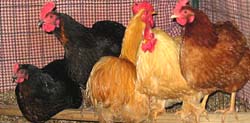
|
| Chickens are being targeted for research. (©2005
Steven Durland) |
By Mike Santa Rita
Maryland Newsline
Thursday, Feb. 10, 2005
A University of Maryland research team is joining forces
with 17 other institutions around the country to try to answer an important
question: How avian flu is transmitted.
Led by an assistant professor
at the
University of Maryland’s
Department of Veterinary Medicine and funded by a $5 million grant from
the U.S. Department of Agriculture, the three-year research project has
implications “both for the poultry industry as well as public health,” said
Peter Johnson, national program leader for animal health at the USDA.
The research program aims to discover what it takes for
avian flu to cross species at the molecular level, said its director, Daniel
Perez. It also aims to educate farmers against interbreeding bird species to
reduce the risk of disease. And it will help provide better tools to farmers to
help them monitor poultry influenza.
The hope is also to develop new or alternative vaccines
for the illness, Perez said.
“There’s never going to be a cure for influenza,” he said.
“You cannot eradicate influenza. But I think you can realistically think of
controlling it or preventing it in poultry of commercial importance.”
An avian
flu outbreak in the Delmarva region last year hit two farms in Delaware and one
in Maryland, resulting in the destruction of
about 350,000 birds. It prompted a $500,000 cleanup
operation, said Sue DuPont, communications director for the Maryland Department
of Agriculture.
The loss to the farming
community was estimated between $3 million and $5 million, said John
Brooks, deputy secretary for the Maryland Department of Agriculture.
The avian flu
strain that hit the Delmarva region was a low-pathogenic strain that is not
deadly to humans, but public health officials were concerned that it could
mutate into a highly pathogenic strain similar to the one that has killed
people in Asia, Brooks said. Farmers were tipped off to the disease when they
noticed a higher mortality rate among their birds, many of whom were becoming
feverish, Brooks said.
In response to the outbreak, Maryland poultry producers
are asking state lawmakers this year to pass legislation that would conceal the
identity of the farms infected with avian flu. They say they want to avoid
embargoes by foreign buyers.
Brooks said his department would be closely monitoring
Perez’s project.
“We will be looking anxiously at the outcomes at how we
can better serve and protect the state of Maryland,” he said, adding that the
consequences of the research move beyond Maryland. “This has national
implications.”
The 18 institutions involved in the project – among them
the Los Alamos National Laboratory at the University of California, the New
York Department of Agriculture, St. Jude's Children's Research Hospital in
Memphis and North Carolina State University-- will share responsibilities and
areas of research.
Perez, a native Argentine who has been working on the
virus since coming to the United States five years ago, said he personally will
focus on how the virus is transmitted.
The virus transmits from chicken to humans easily, Perez
said, but from human to human is another story. “The viruses do not
transmit very well from human to human, and the question is ‘why?’ ”
